Abstract
Electropermeabilized human platelets containing 5-hydroxy[14C]tryptamine ([14C]5-HT) were suspended in a glutamate medium containing ATP and incubated for 10 min with (in various combinations) Ca2+ buffers, phorbol 12-myristate 13-acetate (PMA), guanine nucleotides, and thrombin. Release of [14C]5-HT and beta-thromboglobulin (beta TG) were used to measure secretion from dense and alpha-granules, respectively. Ca2+ alone induced secretion from both granule types; half-maximal effects were seen at a -log [Ca2+ free] (pCa) of 5.5 and maximal secretion at a pCa of 4.5, when approximately 80% of 5-HT and approximately 50% of beta TG were released. Addition of PMA, guanosine 5'-O-(3-thiotriphosphate) (GTP gamma S), GTP, or thrombin shifted the Ca2+ dose-response curves for secretion of both 5-HT and beta TG to the left and caused small increases in the maximum secretion observed. These results suggested that secretion from alpha-granules, like that from dense granules, is a Ca(2+)-dependent process stimulated by the sequential activation of a G-protein, phospholipase C, and protein kinase C (PKC). However, high concentrations of PMA and GTP gamma S had distinct effects in the absence of Ca2+ (pCa greater than 9); 100 nM PMA released approximately 20% of platelet 5-HT but little beta TG, whereas 100 microM GTP gamma S stimulated secretion of approximately 25% of each. Simultaneous addition of PMA greatly enhanced these effects of GTP gamma S. Phosphorylation of pleckstrin in permeabilized platelets incubated with [gamma-32P]ATP was used as an index of the activation of PKC during secretion. In the absence of Ca2+, 100 nM PMA caused maximal phosphorylation of pleckstrin and 100 microM GTP gamma S was approximately 50% as effective as PMA; neither GTP gamma S nor Ca2+ enhanced the phosphorylation of pleckstrin caused by 100 nM PMA. These results indicate that, although activation of PKC promoted secretion, GTP gamma S exerted additional stimulatory effects on secretion from both dense and alpha-granules that were not mediated by PKC. Measurement of [3H]inositol phosphate formation in permeabilized platelets containing [3H]phosphoinositides showed that GTP gamma S did not stimulate phosphoinositide-specific phospholipase C in the absence of Ca2+. It follows that in permeabilized platelets, GTP gamma S can both stimulate PKC and enhance secretion via G-protein-linked effectors other than this phospholipase.
Full text
PDF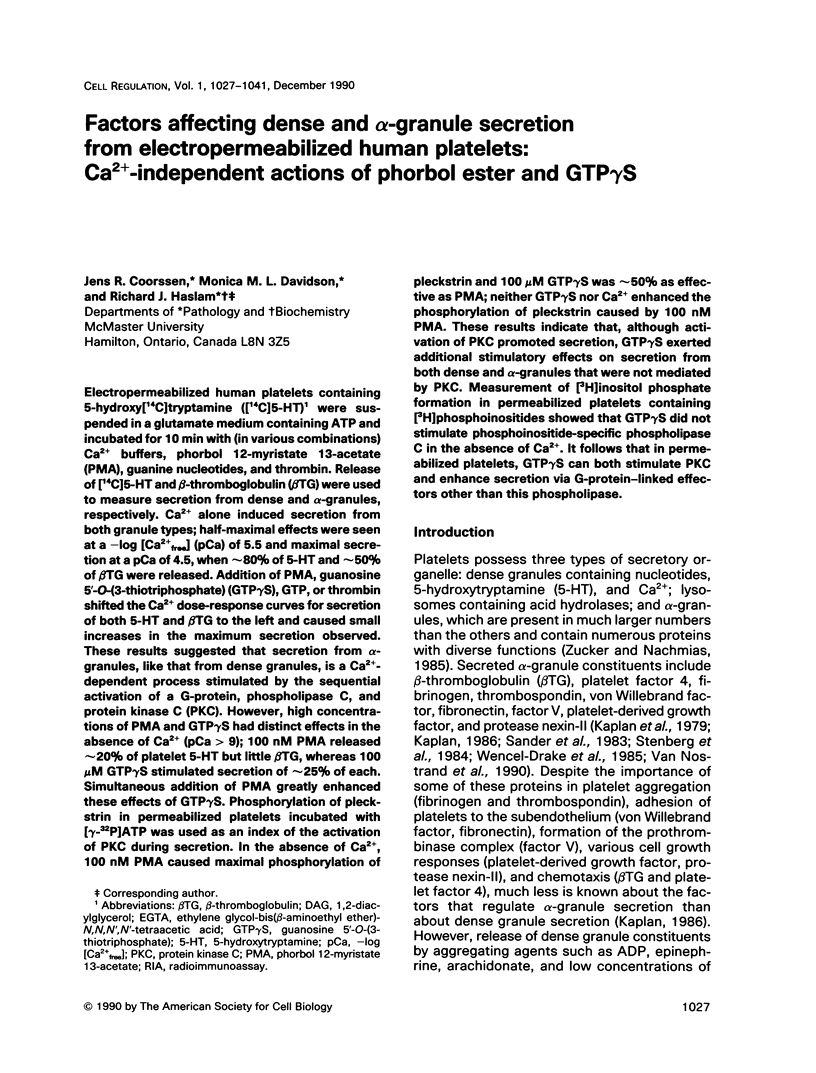
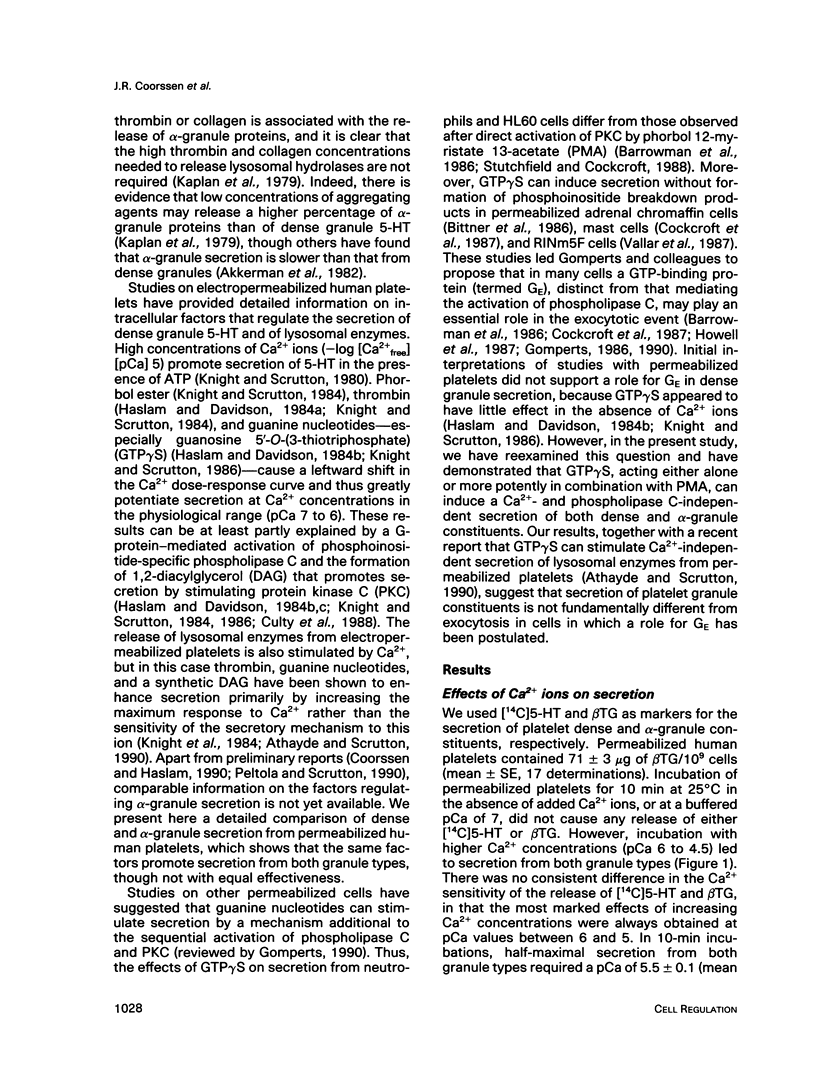
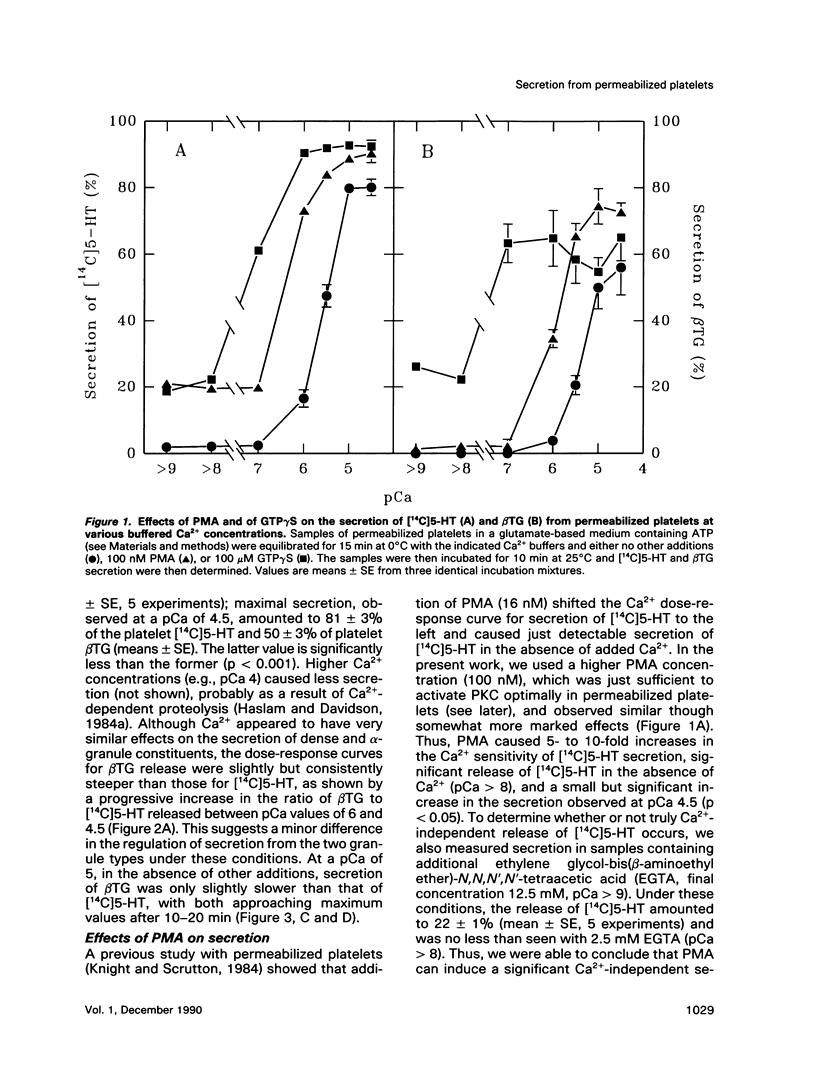
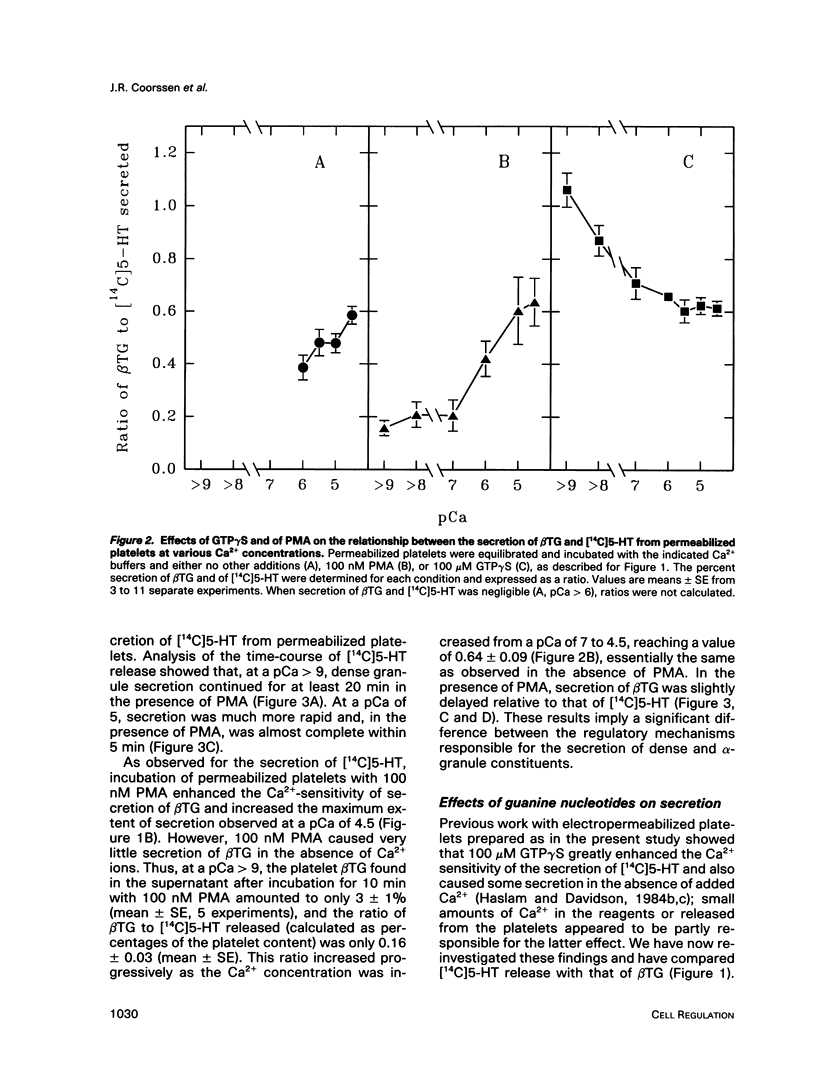
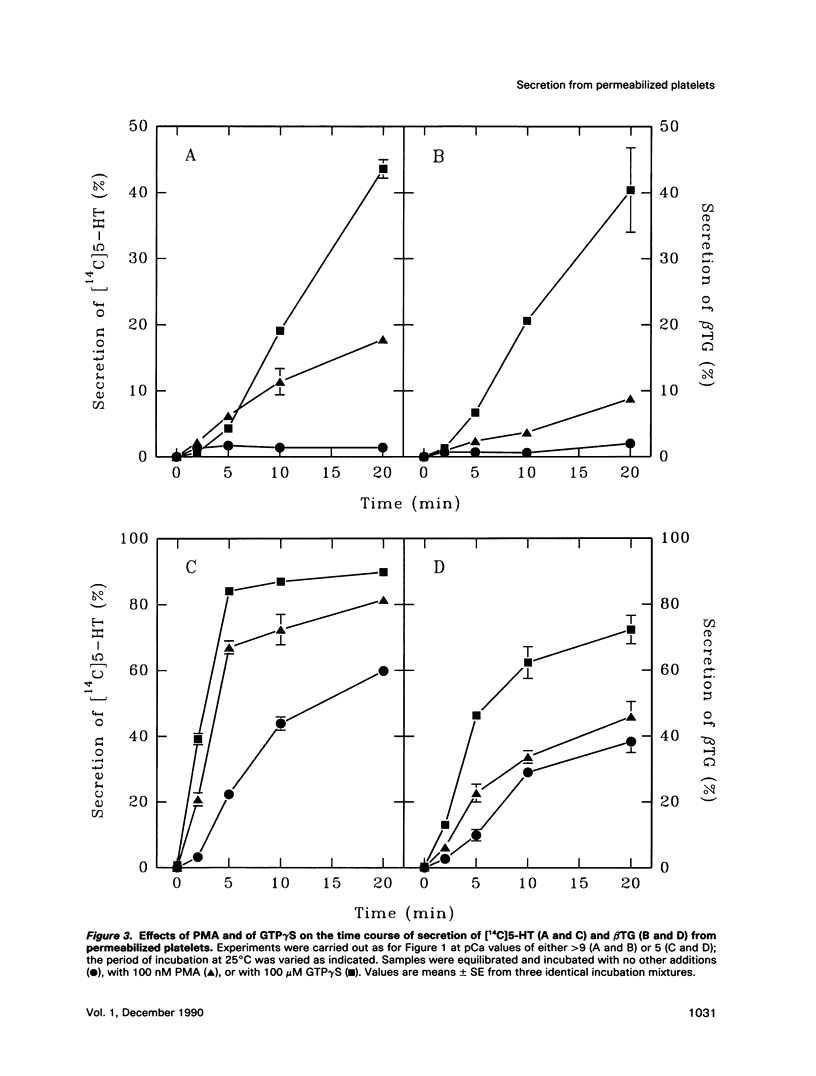
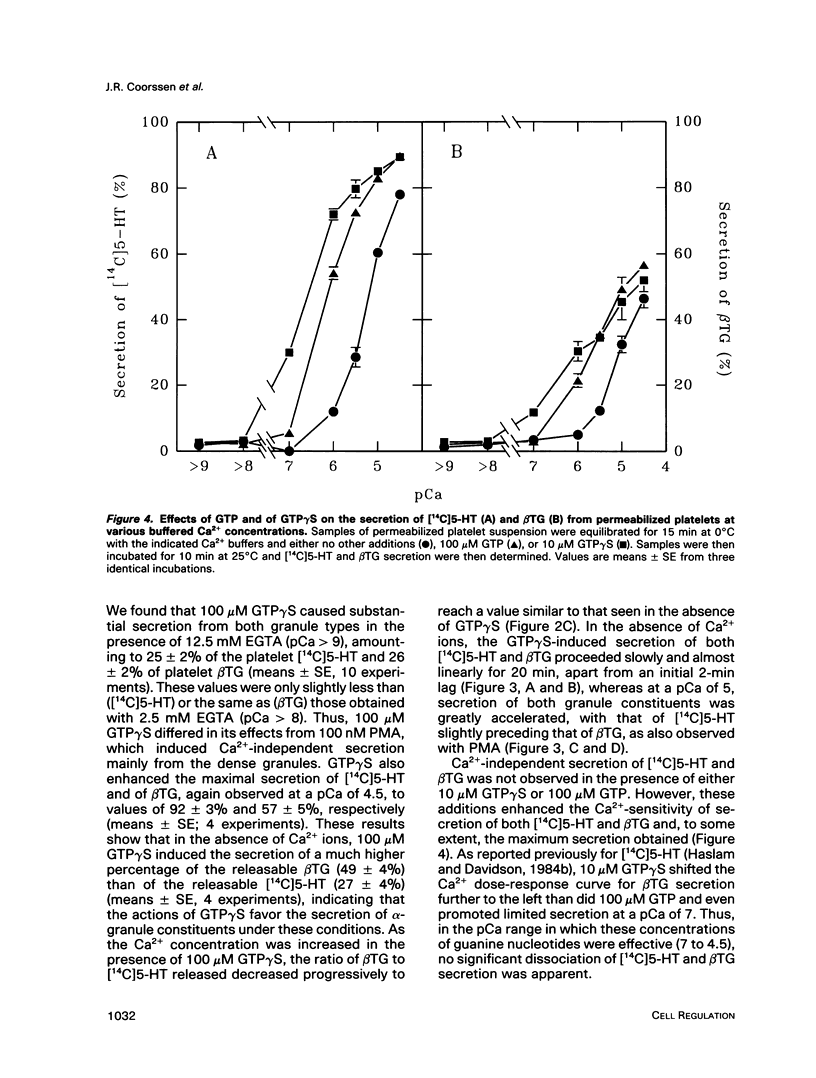
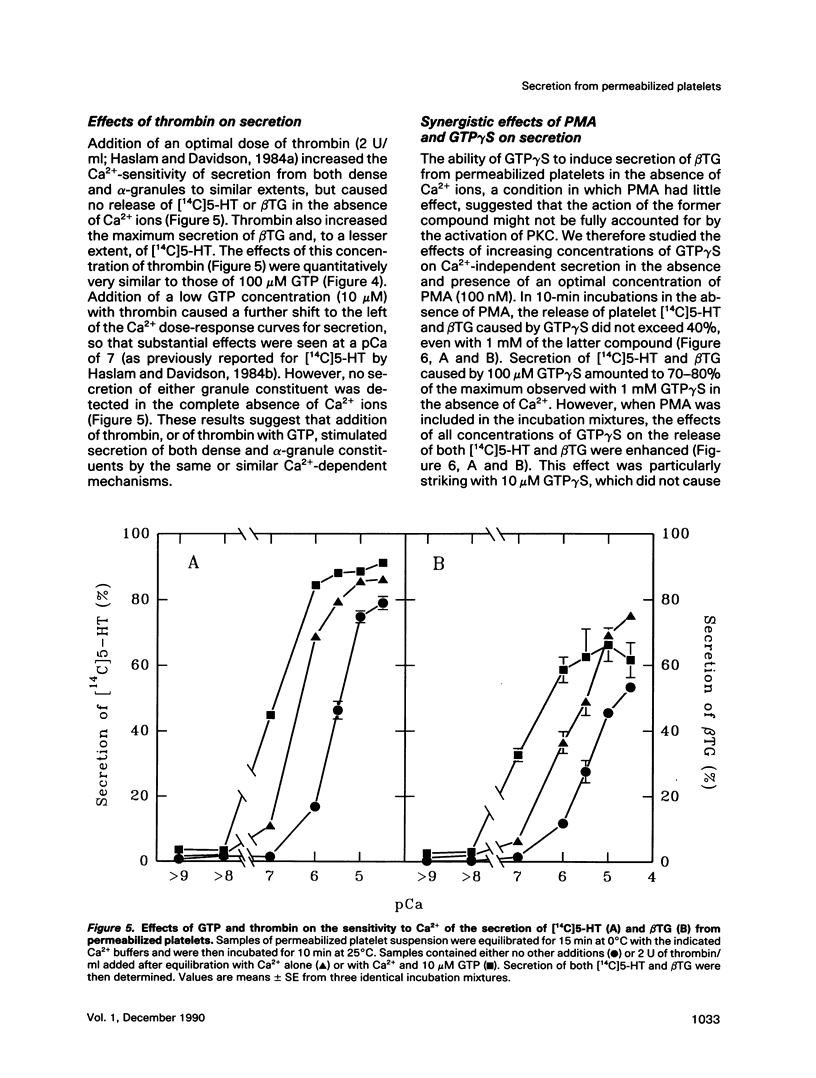
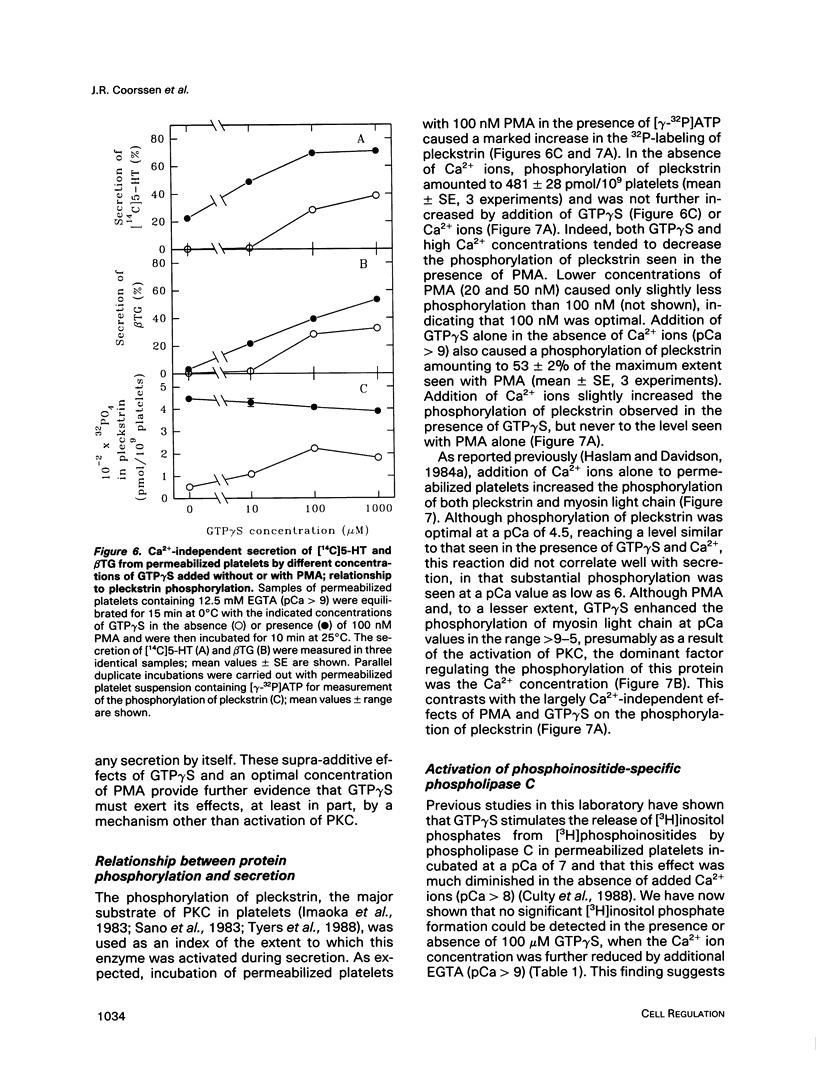
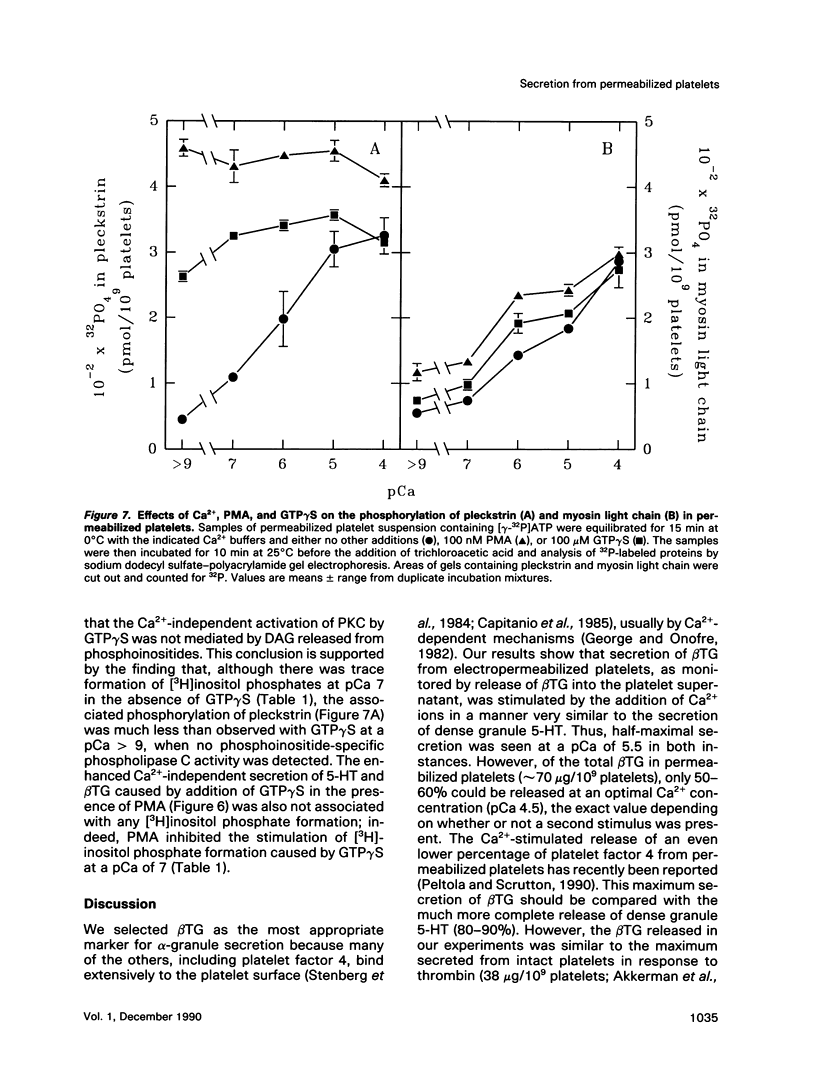
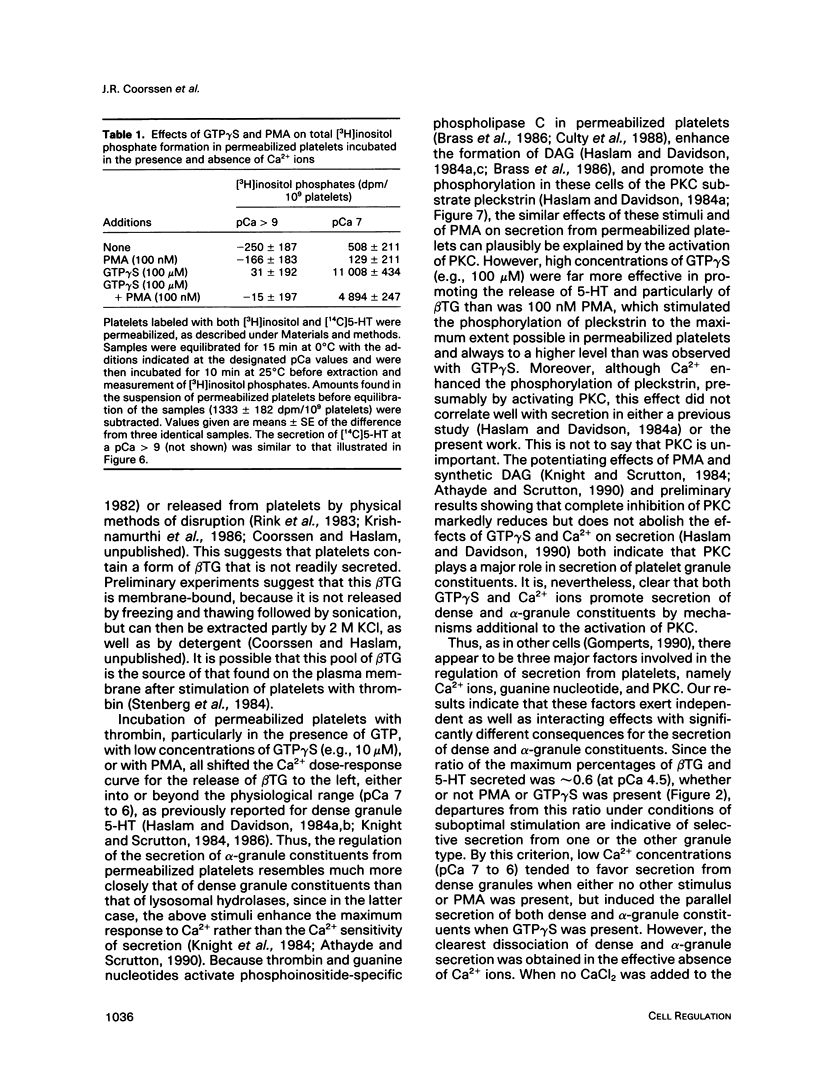
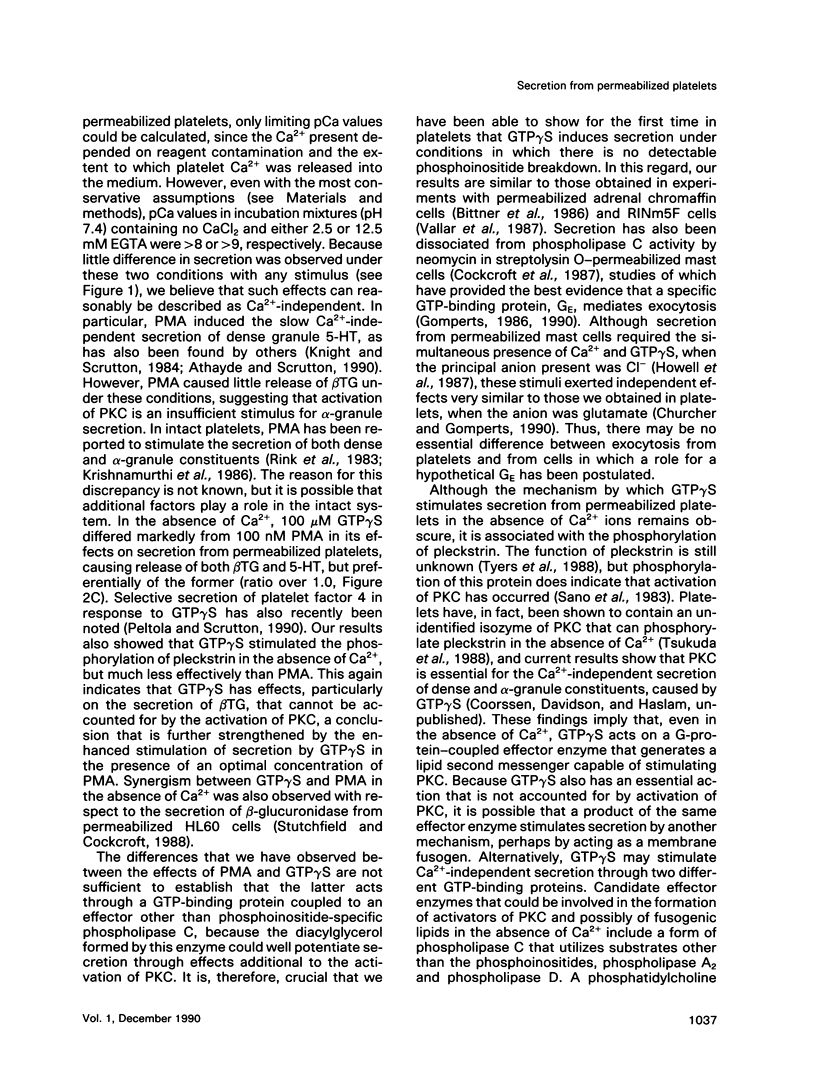
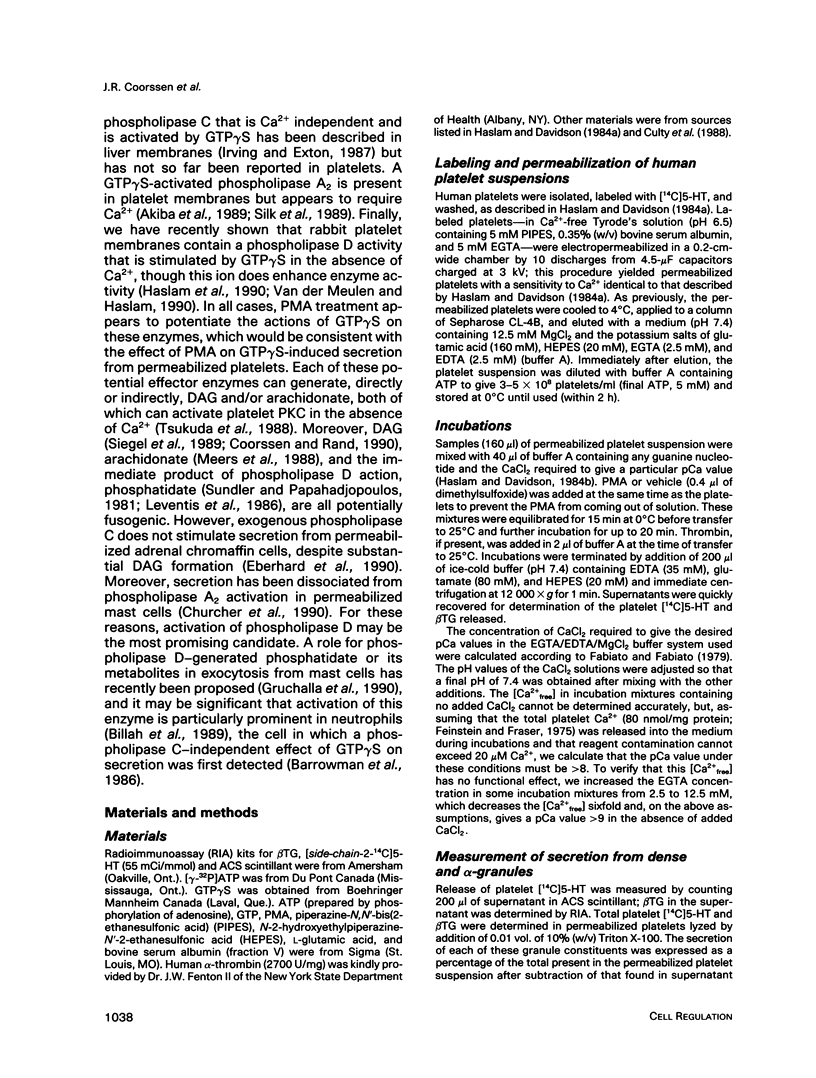
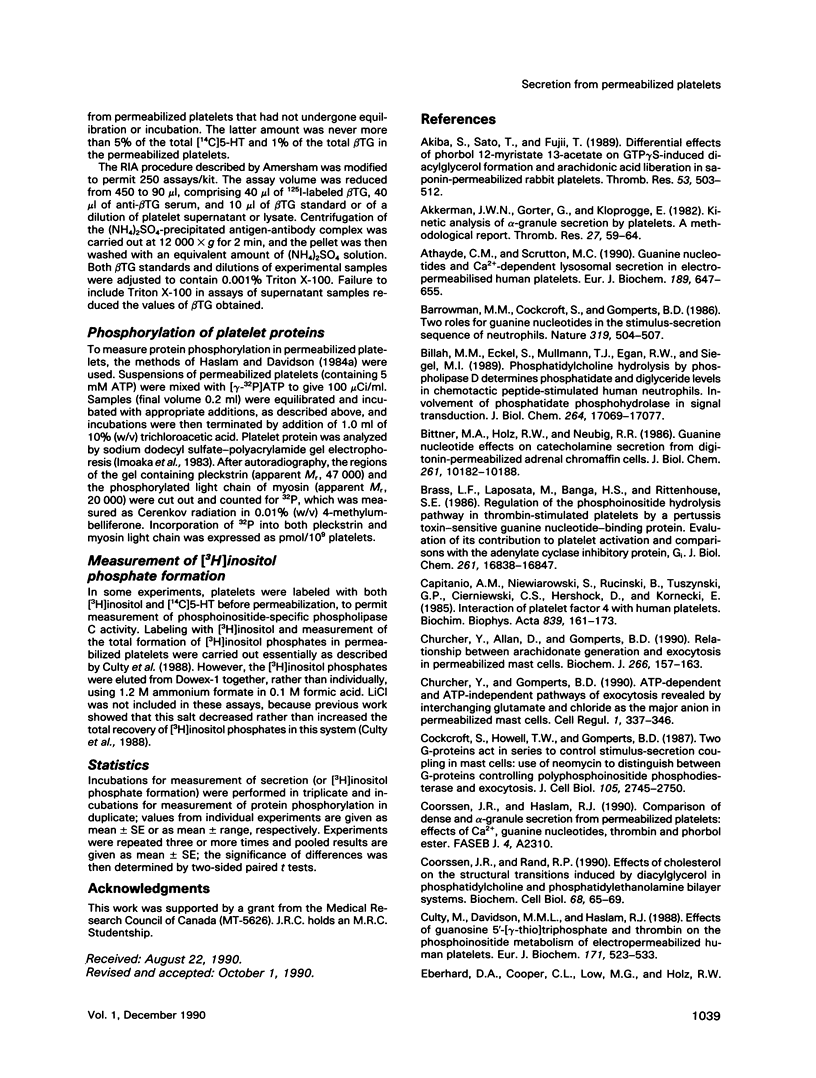
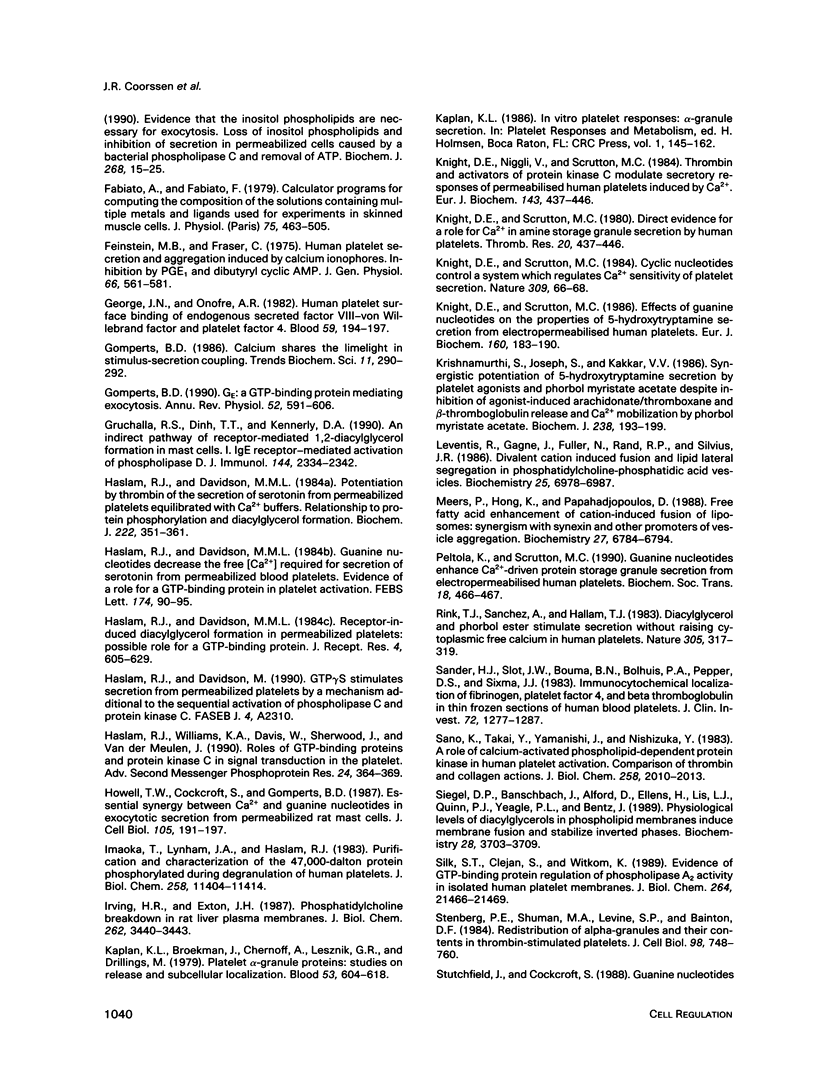
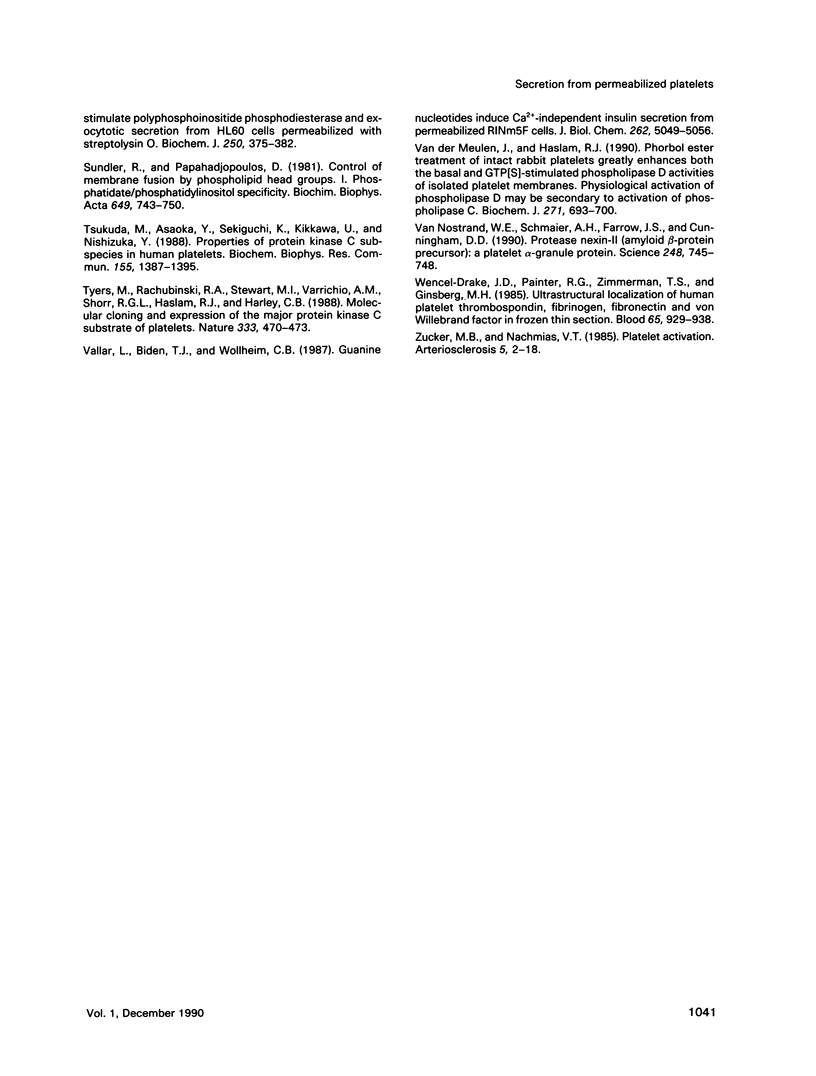
Selected References
These references are in PubMed. This may not be the complete list of references from this article.
- Akiba S., Sato T., Fujii T. Differential effects of phorbol 12-myristate 13-acetate on GTP gamma S-induced diacylglycerol formation and arachidonic acid liberation in saponin-permeabilized rabbit platelets. Thromb Res. 1989 Mar 1;53(5):503–512. doi: 10.1016/0049-3848(89)90205-3. [DOI] [PubMed] [Google Scholar]
- Akkerman J. W., Gorter G., Kloprogge E. Kinetic analysis of alpha-granule secretion by platelets. A methodological report. Thromb Res. 1982 Jul 1;27(1):59–64. doi: 10.1016/0049-3848(82)90278-x. [DOI] [PubMed] [Google Scholar]
- Athayde C. M., Scrutton M. C. Guanine nucleotides and Ca2(+)-dependent lysosomal secretion in electropermeabilised human platelets. Eur J Biochem. 1990 May 20;189(3):647–655. doi: 10.1111/j.1432-1033.1990.tb15533.x. [DOI] [PubMed] [Google Scholar]
- Barrowman M. M., Cockcroft S., Gomperts B. D. Two roles for guanine nucleotides in the stimulus-secretion sequence of neutrophils. Nature. 1986 Feb 6;319(6053):504–507. doi: 10.1038/319504a0. [DOI] [PubMed] [Google Scholar]
- Billah M. M., Eckel S., Mullmann T. J., Egan R. W., Siegel M. I. Phosphatidylcholine hydrolysis by phospholipase D determines phosphatidate and diglyceride levels in chemotactic peptide-stimulated human neutrophils. Involvement of phosphatidate phosphohydrolase in signal transduction. J Biol Chem. 1989 Oct 15;264(29):17069–17077. [PubMed] [Google Scholar]
- Bittner M. A., Holz R. W., Neubig R. R. Guanine nucleotide effects on catecholamine secretion from digitonin-permeabilized adrenal chromaffin cells. J Biol Chem. 1986 Aug 5;261(22):10182–10188. [PubMed] [Google Scholar]
- Brass L. F., Laposata M., Banga H. S., Rittenhouse S. E. Regulation of the phosphoinositide hydrolysis pathway in thrombin-stimulated platelets by a pertussis toxin-sensitive guanine nucleotide-binding protein. Evaluation of its contribution to platelet activation and comparisons with the adenylate cyclase inhibitory protein, Gi. J Biol Chem. 1986 Dec 25;261(36):16838–16847. [PubMed] [Google Scholar]
- Capitanio A. M., Niewiarowski S., Rucinski B., Tuszynski G. P., Cierniewski C. S., Hershock D., Kornecki E. Interaction of platelet factor 4 with human platelets. Biochim Biophys Acta. 1985 Apr 17;839(2):161–173. doi: 10.1016/0304-4165(85)90033-9. [DOI] [PubMed] [Google Scholar]
- Churcher Y., Allan D., Gomperts B. D. Relationship between arachidonate generation and exocytosis in permeabilized mast cells. Biochem J. 1990 Feb 15;266(1):157–163. doi: 10.1042/bj2660157. [DOI] [PMC free article] [PubMed] [Google Scholar]
- Churcher Y., Gomperts B. D. ATP-dependent and ATP-independent pathways of exocytosis revealed by interchanging glutamate and chloride as the major anion in permeabilized mast cells. Cell Regul. 1990 Mar;1(4):337–346. doi: 10.1091/mbc.1.4.337. [DOI] [PMC free article] [PubMed] [Google Scholar]
- Cockcroft S., Howell T. W., Gomperts B. D. Two G-proteins act in series to control stimulus-secretion coupling in mast cells: use of neomycin to distinguish between G-proteins controlling polyphosphoinositide phosphodiesterase and exocytosis. J Cell Biol. 1987 Dec;105(6 Pt 1):2745–2750. doi: 10.1083/jcb.105.6.2745. [DOI] [PMC free article] [PubMed] [Google Scholar]
- Coorssen J. R., Rand R. P. Effects of cholesterol on the structural transitions induced by diacylglycerol in phosphatidylcholine and phosphatidylethanolamine bilayer systems. Biochem Cell Biol. 1990 Jan;68(1):65–69. doi: 10.1139/o90-008. [DOI] [PubMed] [Google Scholar]
- Culty M., Davidson M. M., Haslam R. J. Effects of guanosine 5'-[gamma-thio]triphosphate and thrombin on the phosphoinositide metabolism of electropermeabilized human platelets. Eur J Biochem. 1988 Feb 1;171(3):523–533. doi: 10.1111/j.1432-1033.1988.tb13821.x. [DOI] [PubMed] [Google Scholar]
- Eberhard D. A., Cooper C. L., Low M. G., Holz R. W. Evidence that the inositol phospholipids are necessary for exocytosis. Loss of inositol phospholipids and inhibition of secretion in permeabilized cells caused by a bacterial phospholipase C and removal of ATP. Biochem J. 1990 May 15;268(1):15–25. doi: 10.1042/bj2680015. [DOI] [PMC free article] [PubMed] [Google Scholar]
- Fabiato A., Fabiato F. Calculator programs for computing the composition of the solutions containing multiple metals and ligands used for experiments in skinned muscle cells. J Physiol (Paris) 1979;75(5):463–505. [PubMed] [Google Scholar]
- Feinstein M. B., Fraser C. Human platelet secretion and aggregation induced by calcium ionophores. Inhibition by PGE1 and dibutyryl cyclic AMP. J Gen Physiol. 1975 Nov;66(5):561–581. doi: 10.1085/jgp.66.5.561. [DOI] [PMC free article] [PubMed] [Google Scholar]
- George J. N., Onofre A. R. Human platelet surface binding of endogenous secreted factor VIII-von Willebrand factor and platelet factor 4. Blood. 1982 Jan;59(1):194–197. [PubMed] [Google Scholar]
- Gomperts B. D. GE: a GTP-binding protein mediating exocytosis. Annu Rev Physiol. 1990;52:591–606. doi: 10.1146/annurev.ph.52.030190.003111. [DOI] [PubMed] [Google Scholar]
- Gruchalla R. S., Dinh T. T., Kennerly D. A. An indirect pathway of receptor-mediated 1,2-diacylglycerol formation in mast cells. I. IgE receptor-mediated activation of phospholipase D. J Immunol. 1990 Mar 15;144(6):2334–2342. [PubMed] [Google Scholar]
- Haslam R. J., Davidson M. M. Guanine nucleotides decrease the free [Ca2+] required for secretion of serotonin from permeabilized blood platelets. Evidence of a role for a GTP-binding protein in platelet activation. FEBS Lett. 1984 Aug 20;174(1):90–95. doi: 10.1016/0014-5793(84)81084-4. [DOI] [PubMed] [Google Scholar]
- Haslam R. J., Davidson M. M. Potentiation by thrombin of the secretion of serotonin from permeabilized platelets equilibrated with Ca2+ buffers. Relationship to protein phosphorylation and diacylglycerol formation. Biochem J. 1984 Sep 1;222(2):351–361. doi: 10.1042/bj2220351. [DOI] [PMC free article] [PubMed] [Google Scholar]
- Haslam R. J., Davidson M. M. Receptor-induced diacylglycerol formation in permeabilized platelets; possible role for a GTP-binding protein. J Recept Res. 1984;4(1-6):605–629. doi: 10.3109/10799898409042576. [DOI] [PubMed] [Google Scholar]
- Haslam R. J., Williams K. A., Davis W., Sherwood J., Van der Meulen J. Roles of GTP-binding proteins and protein kinase C in signal transduction in the platelet. Adv Second Messenger Phosphoprotein Res. 1990;24:364–369. [PubMed] [Google Scholar]
- Howell T. W., Cockcroft S., Gomperts B. D. Essential synergy between Ca2+ and guanine nucleotides in exocytotic secretion from permeabilized rat mast cells. J Cell Biol. 1987 Jul;105(1):191–197. doi: 10.1083/jcb.105.1.191. [DOI] [PMC free article] [PubMed] [Google Scholar]
- Imaoka T., Lynham J. A., Haslam R. J. Purification and characterization of the 47,000-dalton protein phosphorylated during degranulation of human platelets. J Biol Chem. 1983 Sep 25;258(18):11404–11414. [PubMed] [Google Scholar]
- Irving H. R., Exton J. H. Phosphatidylcholine breakdown in rat liver plasma membranes. Roles of guanine nucleotides and P2-purinergic agonists. J Biol Chem. 1987 Mar 15;262(8):3440–3443. [PubMed] [Google Scholar]
- Kaplan K. L., Broekman M. J., Chernoff A., Lesznik G. R., Drillings M. Platelet alpha-granule proteins: studies on release and subcellular localization. Blood. 1979 Apr;53(4):604–618. [PubMed] [Google Scholar]
- Knight D. E., Niggli V., Scrutton M. C. Thrombin and activators of protein kinase C modulate secretory responses of permeabilised human platelets induced by Ca2+. Eur J Biochem. 1984 Sep 3;143(2):437–446. doi: 10.1111/j.1432-1033.1984.tb08391.x. [DOI] [PubMed] [Google Scholar]
- Knight D. E., Scrutton M. C. Cyclic nucleotides control a system which regulates Ca2+ sensitivity of platelet secretion. Nature. 1984 May 3;309(5963):66–68. doi: 10.1038/309066a0. [DOI] [PubMed] [Google Scholar]
- Knight D. E., Scrutton M. C. Direct evidence for a role for Ca2+ in amine storage granule secretion by human platelets. Thromb Res. 1980 Nov 15;20(4):437–446. doi: 10.1016/0049-3848(80)90282-0. [DOI] [PubMed] [Google Scholar]
- Knight D. E., Scrutton M. C. Effects of guanine nucleotides on the properties of 5-hydroxytryptamine secretion from electropermeabilised human platelets. Eur J Biochem. 1986 Oct 1;160(1):183–190. doi: 10.1111/j.1432-1033.1986.tb09956.x. [DOI] [PubMed] [Google Scholar]
- Krishnamurthi S., Joseph S., Kakkar V. V. Synergistic potentiation of 5-hydroxytryptamine secretion by platelet agonists and phorbol myristate acetate despite inhibition of agonist-induced arachidonate/thromboxane and beta-thromboglobulin release and Ca2+ mobilization by phorbol myristate acetate. Biochem J. 1986 Aug 15;238(1):193–199. doi: 10.1042/bj2380193. [DOI] [PMC free article] [PubMed] [Google Scholar]
- Leventis R., Gagné J., Fuller N., Rand R. P., Silvius J. R. Divalent cation induced fusion and lipid lateral segregation in phosphatidylcholine-phosphatidic acid vesicles. Biochemistry. 1986 Nov 4;25(22):6978–6987. doi: 10.1021/bi00370a600. [DOI] [PubMed] [Google Scholar]
- Meers P., Hong K., Papahadjopoulos D. Free fatty acid enhancement of cation-induced fusion of liposomes: synergism with synexin and other promoters of vesicle aggregation. Biochemistry. 1988 Sep 6;27(18):6784–6794. doi: 10.1021/bi00418a021. [DOI] [PubMed] [Google Scholar]
- Peltola K., Scrutton M. C. Guanine nucleotides enhance Ca2(+)-driven protein storage granule secretion from electropermeabilized human platelets. Biochem Soc Trans. 1990 Jun;18(3):466–467. doi: 10.1042/bst0180466. [DOI] [PubMed] [Google Scholar]
- Rink T. J., Sanchez A., Hallam T. J. Diacylglycerol and phorbol ester stimulate secretion without raising cytoplasmic free calcium in human platelets. Nature. 1983 Sep 22;305(5932):317–319. doi: 10.1038/305317a0. [DOI] [PubMed] [Google Scholar]
- Sander H. J., Slot J. W., Bouma B. N., Bolhuis P. A., Pepper D. S., Sixma J. J. Immunocytochemical localization of fibrinogen, platelet factor 4, and beta thromboglobulin in thin frozen sections of human blood platelets. J Clin Invest. 1983 Oct;72(4):1277–1287. doi: 10.1172/JCI111084. [DOI] [PMC free article] [PubMed] [Google Scholar]
- Sano K., Takai Y., Yamanishi J., Nishizuka Y. A role of calcium-activated phospholipid-dependent protein kinase in human platelet activation. Comparison of thrombin and collagen actions. J Biol Chem. 1983 Feb 10;258(3):2010–2013. [PubMed] [Google Scholar]
- Siegel D. P., Banschbach J., Alford D., Ellens H., Lis L. J., Quinn P. J., Yeagle P. L., Bentz J. Physiological levels of diacylglycerols in phospholipid membranes induce membrane fusion and stabilize inverted phases. Biochemistry. 1989 May 2;28(9):3703–3709. doi: 10.1021/bi00435a012. [DOI] [PubMed] [Google Scholar]
- Silk S. T., Clejan S., Witkom K. Evidence of GTP-binding protein regulation of phospholipase A2 activity in isolated human platelet membranes. J Biol Chem. 1989 Dec 25;264(36):21466–21469. [PubMed] [Google Scholar]
- Stenberg P. E., Shuman M. A., Levine S. P., Bainton D. F. Redistribution of alpha-granules and their contents in thrombin-stimulated platelets. J Cell Biol. 1984 Feb;98(2):748–760. doi: 10.1083/jcb.98.2.748. [DOI] [PMC free article] [PubMed] [Google Scholar]
- Stutchfield J., Cockcroft S. Guanine nucleotides stimulate polyphosphoinositide phosphodiesterase and exocytotic secretion from HL60 cells permeabilized with streptolysin O. Biochem J. 1988 Mar 1;250(2):375–382. doi: 10.1042/bj2500375. [DOI] [PMC free article] [PubMed] [Google Scholar]
- Sundler R., Papahadjopoulos D. Control of membrane fusion by phospholipid head groups. I. Phosphatidate/phosphatidylinositol specificity. Biochim Biophys Acta. 1981 Dec 21;649(3):743–750. doi: 10.1016/0005-2736(81)90179-6. [DOI] [PubMed] [Google Scholar]
- Tsukuda M., Asaoka Y., Sekiguchi K., Kikkawa U., Nishizuka Y. Properties of protein kinase C subspecies in human platelets. Biochem Biophys Res Commun. 1988 Sep 30;155(3):1387–1395. doi: 10.1016/s0006-291x(88)81295-6. [DOI] [PubMed] [Google Scholar]
- Tyers M., Rachubinski R. A., Stewart M. I., Varrichio A. M., Shorr R. G., Haslam R. J., Harley C. B. Molecular cloning and expression of the major protein kinase C substrate of platelets. Nature. 1988 Jun 2;333(6172):470–473. doi: 10.1038/333470a0. [DOI] [PubMed] [Google Scholar]
- Vallar L., Biden T. J., Wollheim C. B. Guanine nucleotides induce Ca2+-independent insulin secretion from permeabilized RINm5F cells. J Biol Chem. 1987 Apr 15;262(11):5049–5056. [PubMed] [Google Scholar]
- Van Nostrand W. E., Schmaier A. H., Farrow J. S., Cunningham D. D. Protease nexin-II (amyloid beta-protein precursor): a platelet alpha-granule protein. Science. 1990 May 11;248(4956):745–748. doi: 10.1126/science.2110384. [DOI] [PubMed] [Google Scholar]
- Van der Meulen J., Haslam R. J. Phorbol ester treatment of intact rabbit platelets greatly enhances both the basal and guanosine 5'-[gamma-thio]triphosphate-stimulated phospholipase D activities of isolated platelet membranes. Physiological activation of phospholipase D may be secondary to activation of phospholipase C. Biochem J. 1990 Nov 1;271(3):693–700. doi: 10.1042/bj2710693. [DOI] [PMC free article] [PubMed] [Google Scholar]
- Wencel-Drake J. D., Painter R. G., Zimmerman T. S., Ginsberg M. H. Ultrastructural localization of human platelet thrombospondin, fibrinogen, fibronectin, and von Willebrand factor in frozen thin section. Blood. 1985 Apr;65(4):929–938. [PubMed] [Google Scholar]
- Zucker M. B., Nachmias V. T. Platelet activation. Arteriosclerosis. 1985 Jan-Feb;5(1):2–18. doi: 10.1161/01.atv.5.1.2. [DOI] [PubMed] [Google Scholar]


